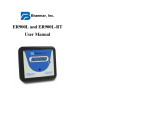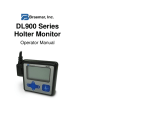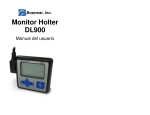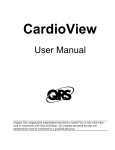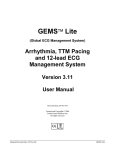Download Braemar Side Series Operating instructions
Transcript
Braemar, Inc. ER910, 920 And ER910, 920 AF Arrhythmia Event Monitor Caution: U.S. Federal law restricts this device to sale by or on the order of a physician. Braemar Limited Warranty Braemar products are warranted to be free from manufacturing and material defects for a period of one (1) year from the date of shipment from Braemar to the original purchaser. Excluded from this warranty are expendable supply items including, but not limited to, electrodes, lead wires, patient cables and batteries. This warranty does not apply to any product which Braemar determines has been modified or damaged by the customer. Except for the express warranties stated above, Braemar disclaims all warranties including implied warranties of merchantability and fitness. The stated express warranties are in lieu of all obligations of liabilities on the part of Braemar for damages, including but not limited to, special indirect or consequential, arising out of or in connection with the use or performance of Braemar products. Any action for breach of warranty shall be commenced within one (1) year of said breach or be forever barred. Any repairs made to the product which are not covered by the warranty shall be billed to the customer. Document Number: 600-0606-00 Revision: K Date: December 2008 ER910/920 and ER910/920 AF Event Monitor Table of Contents ER910/920 and ER910/920 AF Event Monitor Overview Overview...................................................................................................2 Indications for Use ....................................................................................2 Precautions...............................................................................................2 Monitor Components ................................................................................3 Setup Steps ..............................................................................................4 Electrode Application and Placement .......................................................4 1 and 2 Channel (4 Lead) Electrode Placement .......................................5 Monitor Preparation ..................................................................................6 Patient Operating Instructions ................................................................13 Troubleshooting......................................................................................16 Event Markings.......................................................................................18 Service and Maintenance .......................................................................19 Service Items and Accessories...............................................................19 Equipment Symbols................................................................................20 Specifications .........................................................................................21 Electromagnetic Emissions.....................................................................23 Electromagnetic Immunity ......................................................................23 Recommended Separation Distances ....................................................26 1 The ER910/920 and ER910/920 AF Event Monitors are battery operated, solid state, looping event recorders designed to record symptomatic heart arrhythmias. Event recording is activated by the patient or by automatic event detection. The ER910 (1 channel) and ER920 (2 channel) event monitors provide up to 30 minutes of total recording time and will operate as a simple looping event recorder for a minimum of 30 days with two AAA Alkaline batteries. They offer multiple programmed recording options allowing the physician to determine their own parameters. Selectable parameters include number of events, pre-event time, post-event time, audible operation, pacemaker detection, and arrhythmia detection. The ER910/920 Event Monitors are enhanced with Arrhythmia Detection firmware which will capture and automatically record asymptomatic, infrequent, or elusive heart arrhythmia events such as Bradycardia, Tachycardia, and Pause. The ER910/920 AF includes all of these features and in addition, Atrial Fibrillation. Once an event is recorded, patients may transmit their ECG transtelephonically. Indications for Use The device is indicated for diagnostic evaluation of patients who experience transient symptoms such as; dizziness, palpitations, syncope, or chest pain. The device is intended to record cardiac activity associated with these infrequent and transient symptoms. Once data is recorded, patients transmit the recorded ECG data over the telephone or directly to a host PC for review by a licensed physician. Precautions A. Patient leads must be removed from electrodes before defibrillation. B. Observe local laws for disposal of alkaline batteries. C. Do not leave the batteries in the Monitor when it is not in use. Damage from corrosion could result. D. Patient should be instructed to avoid close proximity to heavy electrical equipment or other sources of electromagnetic interference. E. Use of rechargeable batteries is not recommended. F. Do not use cellular phone to transmit patient data. G. Monitor is not for infant use. H. No automatic analysis algorithm can replace data review by a qualified physician. Review and confirmation of analysis results is required. 2 ER910/920 and ER910/920 AF Event Monitor ER910/920 and ER910/920 AF Event Monitor Setup Steps Monitor Components This manual is designed to allow a technician to follow the instructions page by page to setup the ER910/920 and ER910/920 AF Monitor. Here is the general layout: 1. Connect leads and electrodes to patient. 2. Prepare Monitor for recording. A. Choose/Setup program you want to use. B. Erase all previous events. 3. Connect Patient Cable to Monitor. Electrode Application and Placement Batteries Two 1.5V AAA Alkaline. Insert into battery compartment observing polarity symbols. Belt clip To attach, snap the Monitor into the belt clip with Patient Cable oriented up and the display facing out. Necklace To attach, remove battery cover, insert necklace T’s into slots in case. Replace battery cover. To adjust, move plastic slip rings up or down to keep leads together. To lengthen, pull leads apart. Patient Cable 3 For each electrode lead wire: 1. Snap the electrode onto the lead wire. 2. Remove the protective backing from the adhesive side of the electrode. 3. Apply the electrode to the patient’s skin per Electrode Placement diagram in this manual or as instructed by the physician. Notes: A. You must use a Patient Cable that the Monitor is able to recognize. As an example, you cannot use a 2 channel cable with a 1 channel Monitor. B. It is recommended that trained medical personnel instruct the patient in the proper application of electrodes. C. Use good quality long term electrodes. Braemar recommends the use of low impedance Holter electrodes. Instruct patient to apply fresh electrodes regularly. (Usually on a daily basis.) D. Proper preparation of the patient's skin is absolutely essential for obtaining a quality ECG recording. The skin surface where the electrodes will be placed should be cleaned with alcohol, allowed to dry, and abraded. E. Any loose electrode needs to be replaced. 4 ER910/920 and ER910/920 AF Event Monitor 1 and 2 Channel (4 Lead) Electrode Placement ER910/920 and ER910/920 AF Event Monitor Monitor Preparation 1. General setup: Remove the Patient Cable if it is connected to the Monitor. Open the battery compartment by sliding battery door downward. Install two fresh AAA Alkaline batteries. Observe proper battery polarity. The Monitor will sound rising tones after completion of power up. After a few seconds, the display will show the battery level and number of events stored. The battery level should be near 100%. The number of events stored does not matter at this point. 2. Enter programming mode: A. Push and hold both program buttons on the front of the Monitor for two seconds until an audible tone is heard. B. The Monitor will then display an information screen. Press the RECORD/SEND button to get to the programming mode screen. This is a typical electrode placement. Refer to Analysis System software and the physician for recommended positioning. 1 and 2 Channel Electrode Placement Use only Channel 1 if you have a single channel cable. Channel 1 Channel 2 = White and Red (V5 vector) = Black and Brown (V1 vector) 5 6 ER910/920 and ER910/920 AF Event Monitor ER910/920 and ER910/920 AF Event Monitor General notes: A. To leave the programming mode without saving your changes, remove the batteries. B. If you enter the programming mode, events stored in the Monitor are always erased when the Monitor restarts and a Patient Cable is connected. C. All previously stored events and settings are erased when you select EXIT on the last programming screen. D. The Monitor always highlights the DEFAULT option when entering programming mode even if the CUSTOM option was last used. This is only visual. Whatever option was used for a previous recording will continue to be used. E. Previously saved settings are displayed when in the CUSTOM option. F. Factory default settings are indicated by a “ )( ” in front of the setting. G. Use the program buttons to change the program settings and press the RECORD/SEND button to confirm the setting you have chosen. Pressing RECORD/SEND also advances the screen to the next program setting. H. Lead loss detection is on all the time. I. The number of channels a Patient Cable contains will determine the number of channels the Monitor will record. Notes about sound: A. Lead loss sound overrides the POST-EVENT SOUND setting. B. If the Monitor has lead loss during a recording, the Monitor will produce an audible sound of the event until the recording is complete. You can mute this sound by using the AUDIO setting after the recording is complete. C. The AUDIO setting can only be accessed before or after an event is recorded. Trying to access the AUDIO setting during a recording will cause the recording to stop. D. The AUDIO setting controls many of the sounds the patient will hear while wearing the Monitor and may be turned ON or OFF. The AUDIO screen can be accessed during normal monitoring conditions (Patient Cable inserted) by pressing only one of the programming buttons for two seconds. The AUDIO screen will exit after 10 seconds of inactivity. E. The AUDIO setting defaults to ON every time the Monitor is powered up. F. The AUDIO setting defaults to ON every time the Patient Cable is removed. This is to enable the Monitor to send events to the receiving center. G. Table of sound settings: (number indicates importance, 1st, 2nd, 3rd) Screen Setting ↓ Note about Arrhythmia and AFIB detection: A. To change Arrhythmia and AFIB settings you must access the CUSTOM program option. B. The Arrhythmia and AFIB algorithms can be used independently of each other. C. Although the device detection algorithms are very sophisticated, there is no guarantee that the device will catch all episodes of arrhythmia. For maximum efficacy, use the most sensitive settings. 7 POSTEVENT NA Monitor Sound ↓ Power on tones Cable detect NA AUDIO NA NA Auto event record 2 nd 1st Manual event record 2nd 1st Prog button press NA 1st Phone ring at end of a recording NA 1st Phone ring for memory full NA 1st Lead loss during recording LL overrides 1st 8 ER910/920 and ER910/920 AF Event Monitor 3. Choose program: Choose either the DEFAULT or CUSTOM option. The DEFAULT option only allows you to change the Contrast of the display. The CUSTOM option allows changes to all of the following settings. Note: A. Factory default settings in the Monitor are indicated by a “ )( ” in front of the setting. B. To see the default values for the Monitor, enter the programming mode and choose DEFAULT. The Monitor will restart. Enter the programming mode again and choose CUSTOM. All the values displayed will be the defaults. There is space available on the next pages to write the default of the Monitor. C. Choosing the DEFAULT option will program the monitor with the factory default values, erase previous patient data, and restart the monitor. Programming settings: Display Option DISPLAY CONTRAST Default = NA Description Set the contrast of the display. A higher number will cause darker text on the screen. PRE-EVENT TIME Default = 60 sec POST-EVENT TIME Default = 30 sec # OF EVENTS Default = 5 ER910/920 and ER910/920 AF Event Monitor User Defined options continued Display Option POST-EVENT SOUND Default = ON Description ON = Sound on while recording during the Post-Event time. OFF = Sound off while recording an event. See Notes about sound for additional information. ON = Ring every hour when an event is stored in memory. OFF = Do not remind patient an event is stored in memory. HOURLY REMINDER Default = ON PREVIEW TIME Default = 10 sec The number of seconds the ECG signal is displayed for each channel when a Patient Cable is inserted. TRANSMIT SPEED The speed used for transmission of data to the receiving center. Default = 3X PACEMAKER DETECTION Turn Pacemaker stimulus detection ON/OFF Default = OFF Seconds of ECG data stored before event activation time. 300 seconds total can be split between Pre and Post events. (minimum of 5 sec) Seconds of ECG data stored after event activation time. (minimum of 5 sec) ARRHYTHMIA DETECTION Default = ON Total number of events the Monitor will store. The maximum number allowed is dependent on Pre and Post Event times. TACHY RATE Turn Arrhythmia Detection ON/OFF. When ON, The Brady Rate, Tachy Rate, and Pause Duration Threshold can be set. BRADY RATE Default = 45 bpm Default = 140 bpm (Arrhythmia Detection must be on to access this function) (Arrhythmia Detection must be on to access this function) Continue on next page Continue on next page 9 10 ER910/920 and ER910/920 AF Event Monitor User Defined options continued Display Option Description PAUSE DURATION THRESHOLD (Arrhythmia Detection must be on to access this function) Default = 3.0 sec 4. 5. Connect the patient: A. At this time, the patient leads should be connected to the electrodes and the electrodes should be connected to the patient. B. Insert the Patient Cable into the Monitor. Notes: • AFIB DETECTION Default = ON -ER910/920 AF devices only- EXIT OR REVIEW PROGRAM See step about leaving programming mode for information. Leave programming mode and erase events: Choose EXIT from the last programming mode screen and press the RECORD/SEND button. The Monitor will restart Note: A. Choosing EXIT will erase all stored events and save your settings over the top of previous program settings. Choosing REVIEW will allow you to changes program settings. Alternate way to erase events: If you don’t want to enter the programming mode, you can also erase events by the following sequence. A. Remove the Patient Cable. B. Hold the RECORD/SEND button for two seconds until audible tone is heard. You will hear the transmission of any events stored in the Monitor. At the end of the transmission you will hear a falling tone and the Monitor will display STOPPED in the upper left. C. Inserting the Patient Cable at this time will erase all events and restart the Monitor. 11 ER910/920 and ER910/920 AF Event Monitor If the patient is connected correctly, the Monitor will sound one beep for a single channel cable or two beeps for a two channel cable C. View the display just after the Patient Cable is connected. It will show the signal from each channel of the cable. Notes: 6. • There will be an accompanying beep for the channel number displayed. • The Monitor will not respond to any button presses during the preview time. • A square wave will continue to be displayed if there is not a good connection to the patient. A good ECG signal must be found before the Monitor will start to look for events. The Monitor is ready to record events. A. The general settings of the Monitor are displayed during operation by the number of dots after the word “MONITORING”. Display Setting MONITORING No Arrhythmia or AFIB MONITORING. Arrhythmia only MONITORING.. Arrhythmia and AFIB MONITORING… AFIB only 12 ER910/920 and ER910/920 AF Event Monitor Patient Operating Instructions The Monitor should be ready when you receive it from the technician. If there are any problems, refer to the Troubleshooting section. Display overview: ER910/920 and ER910/920 AF Event Monitor To Record: Events to be recorded will be described by the physician. 1. Press the RECORD/SEND button for two seconds until an audible tone is heard, then release. Notes: A. There are two RECORD/SEND buttons; you only need to push one of them for two seconds to activate the Monitor. B. To stop a recording, press the RECORD/SEND button again for two seconds. C. “RECORDING” will flash in the upper left hand corner of the display. 2. Hold as still as possible during recording but continue breathing. 3. The recording is complete and ready to send when a phone ring is To Hookup: 1. Snap lead wires onto electrodes first, then apply electrodes according to physician instructions. 2. Reapply fresh electrodes daily. 3. Insert the Patient Cable into the Monitor. Notes: A. Depending on the cable, there should be a single or double beep that indicates a good patient connection. If no beep is heard, double check cable connections. B. Viewing the display just after the Patient Cable is connected will show the signals from each of the channels. There will also be an accompanying beep for the channel number displayed. C. The Monitor will not respond to any button presses during the preview time. D. A square wave will continue to be displayed if there is not a good connection to the patient. A good ECG signal must be found before the Monitor will start to look for events. 4. The Monitor is now looping and ready to record. 13 heard from the Monitor. Notes: A. The display will also show that an event is stored in the Monitor. If the memory is full, follow instructions To Send and Erase Events B. You can mute many of the sounds from the Monitor by pressing only one of the programming buttons for two seconds. This will show a screen that allows you to select whether AUDIO for the Monitor is turned ON or OFF. C. The AUDIO setting defaults to ON every time the Monitor is powered up. D. The AUDIO setting defaults to ON every time the Patient Cable is removed. This is to enable the Monitor to send events to the receiving center. Automatic Record: If Arrhythmia Detection is ON and an event is detected, the Monitor will beep at the start of the recording. The recording is complete and ready to send when a phone ring is heard from the Monitor. An event will also show on the display. A. The last event location is always reserved for a manual recording. 14 ER910/920 and ER910/920 AF Event Monitor To Send: 1. Remove the Patient Cable from the Monitor. 2. Set the Monitor on a flat surface with the speaker hole up. 3. Call the receiving center. A. Cell phones and VOIP phones do not work for the transmission. 4. Follow receiving center instructions. A. When instructed, place the telephone mouthpiece over the Monitor speaker hole. B. Push the RECORD/SEND button for two seconds. The Monitor will make audible tones and “SENDING” will be shown in the upper left hand corner of the display while the recording is being sent. • A falling tone will sound when the transmission is complete and “STOPPED” or “MEMORY FULL” will be shown in the upper left hand corner of the display. • 5. Pressing RECORD/SEND for two seconds during transmission will abort the transmission. Pressing RECORD/SEND again will re-send the recording. When instructed that the events have been sent successfully, it is OK to erase events by reinserting Patient Cable. (The Monitor will restart and you will then hear a rising tone.) Erase Events: 1. Complete the “To Send” section above first. 2. Insert the Patient Cable. The Monitor will restart and emit a rising tone. A. The Monitor will display each ECG signal for 5-30 seconds and then return to the main monitoring screen. B. The number of events on the right hand side should display 0. 3. The Monitor is now looping and ready to record new events. 15 ER910/920 and ER910/920 AF Event Monitor Troubleshooting (page 1 of 2) Symptom Recommended Solution No display Cannot enter programming mode Cannot access AUDIO setting, Patient wants to mute Monitor. Ensure batteries are inserted with correct polarity. The Patient Cable must be removed and the batteries installed. Then follow instruction in manual. A good connection must be made from the Monitor to the patient to be able to access the AUDIO setting. While monitoring, press and hold only one of the programming buttons for two seconds to access the AUDIO setting. AUDIO setting cannot be accessed during a recording. Wait until end of recording, then access AUDIO screen. The AUDIO setting is turned on which mutes most sounds. No phone ring at end of recording No beep when inserting Patient Cable Will not record Monitor stops recording. Siren (alternating) tone while recording Monitor restarts and erases stored events Phone ring sound every hour Phone ring sound every minute for 10 minutes Phone ring sound when RECORD/SEND button is pushed Phone ring sound once Three beeps every five minutes with cable inserted Ensure patient electrodes/leads are connected to patient properly. Is the Patient Cable damaged in some way? Ensure Patient Cable is inserted completely. Patient Cable has more channels than Monitor can use. Match the number channels for the cable and Monitor. Memory full-Phone Ring. Follow instructions To Send and Erase Events. Ensure Patient Cable is inserted completely. Ensure RECORD/SEND button is held for two seconds. Holding any button for two seconds while recording will cause the Monitor to stop recording. This includes trying to access the AUDIO setting There is not a good connection. Check that electrodes/leads have a good connection to patient and cable is plugged into Monitor Changing the Patient Cable to a different number of channels tells the Monitor to restart and erase all events. Memory has event(s) to be transmitted to the receiving center. Memory is full; follow instructions To Send and Erase Events. Memory is full; follow instructions To Send and Erase Events. An event is already stored in memory at start up, also heard at the end of a recorded event. Follow instructions To Send and Erase Events. Batteries are low. Replace batteries and/or clean battery contacts 16 ER910/920 and ER910/920 AF Event Monitor ER910/920 and ER910/920 AF Event Monitor Event Markings Troubleshooting (page 2 of 2) No information received by receiving center Noise artifact on recorded ECG at receiving center Noise artifact on recorded ECG at patient location All or groups of timestamps for recordings are the same. Falling tone Rising tone Make sure mouthpiece of phone is directly over Monitor speaker Ensure RECORD/SEND button is held for two seconds. Mouthpiece of phone must be close to the Monitor speaker hole. Check telephone connection. Listen to phone line before sending event(s) to ensure there is no noise. Have patient call back and send ECG again. Have patient try another phone. Electrodes must be securely attached to patient. Patient should remain still while recording. Replace Patient Cable. Pulling on lead wires may damage cable. Verify the recording did not take place near a source of electromagnetic interference (fluorescent lights, computer monitors, or household appliances). Move electrodes slightly to the right or left of the original location. If the inadvertent loss of power occurs, all the timestamps in the FSK will reset to the time the unit powered back up. Subsequent recordings will have time stamps relative to the power up time. Transmission complete Ready to record 17 The following shows typical event markings that are generated by the Monitor and appear on the receiving station strip chart. 18 ER910/920 and ER910/920 AF Event Monitor ER910/920 and ER910/920 AF Event Monitor Service and Maintenance Cleaning Remove the batteries before cleaning the recorder. Clean the battery terminals with a soft dry cloth. Dampen a soft cloth with mild detergent and water to clean the recorder, lead wires, and belt clip. Equipment Symbols Symbol Description Type B Applied Part Remove any adhesives from the patient lead wires with an adhesive tape remover solution or swab. Use a mild disinfectant. Do not use alcohol or acetone on the lead wires since they could stiffen and the insulating plastic could crack. Service If there is a problem with the Monitor, review the problem descriptions and solutions listed on the next page. If additional assistance is required contact customer support via phone, Fax or E-mail listed below. Call customer support before returning a Monitor to make shipping arrangements. A. Note there isn’t any preventative inspection or maintenance that can be performed by the end user. SN Serial Number 0086 Complies with the Medical Device Directive of the European Union. Waste Electrical and Electronic Equipment (WEEE) It is the responsibility of the end user to dispose of this equipment at a designated collection point for recycling. Date of Manufacture Manufacturer: Braemar, Inc. Service Items and Accessories Description Patient lead, 1 channel, shielded Patient lead, 2 channel, shielded Monitor belt clip / Holster Necklace Operator manual AAA I.E.C. LR03 Alkaline Battery Consult manual. Part Number 350-0173-09 350-0173-10 100-1764-002 350-0180-00 600-0606-00 200-2492-001 1285 Corporate Center Drive, Suite 150 Eagan, MN 55121 USA Phone: Fax: E-mail: Web: 800.328.2719 651.286.8620 651.286.8630 [email protected] http://www.braemarinc.com Contact Braemar for further technical information. Authorized European Rep: QNET BV Hommerterweg 286 6436 AM Amstenrade The Netherlands 19 20 ER910/920 and ER910/920 AF Event Monitor Additional equipment classification information as required in EN 60601-1 A. EQUIPMENT not suitable for use in the presence of a FLAMMABLE ANAESTHETIC MIXTURE WITH AIR of WITH OXYGEN OR NITROUS OXIDE B. IPX0 Ordinary Equipment (enclosed equipment without protection against ingress of water) C. Internally Powered Equipment D. Mode of Operation - Continuous Operation ER910/920 and ER910/920 AF Event Monitor Specifications Functional ER910 ER920 Max Number of events Sample rate User interface Memory Max event time One channel Two channel Max total record time One channel Two channel Type Data retention Physical Dimensions 30 minutes 30 minutes 30 minutes 30 minutes Flash Non-volatile Weight with batteries Enclosure Operating position 3.5"x 2.125"x .65" (89.9mm x 54.0mm x 15.7mm) 3.5 oz. Molded plastic Any orientation Electrical Input impedance CMR ratio AC signal range DC signal range Resolution Frequency response 2M min. 60dB +/- 3mV +/- 300mV 23uV (8bits) .05Hz to 40Hz Environmental Operating temperature Non-operating temperature Operating humidity Non-Operating humidity 0°C to +45°C -20°C to +65°C 10% to 95% (non-condensing) 5% to 95% Transtelephonic Transmission Transmit carrier Carrier deviation 1900Hz 100Hz/mV Battery Type Life Warranty 21 1 channel only 1 or 2 channel 30 256 samples per second LCD display and sound (2) AAA Alkaline IEC-LR3 30 days min. during looping recording Remove batteries during storage 12 months from shipment 22 ER910/920 and ER910/920 AF Event Monitor ER910/920 and ER910/920 AF Event Monitor Electromagnetic Emissions Emissions test Compliance Electromagnetic environment - guidance RF emissions CISPR 11 Group 1 The ER9xx uses RF energy only for its internal function. Therefore, its RF emissions are very low and are not likely to cause any interference in nearby electronic equipment. RF emissions CISPR 11 Class B The ER9xx is suitable for use in all establishments, including domestic establishments and those directly connected to the public lowvoltage power supply network that supplies buildings used for domestic purposes. Electromagnetic Immunity Immunity test IEC 60601 test level Compliance level Electromagnetic environment - guidance Electrostatic ±6 kV contact ±6 kV contact Floors should be wood, discharge (ESD) concrete or ceramic tile. If ±8 kV air ±8 kV air floors are covered with IEC 61000-4-2 synthetic material, the relative humidity should be at least 30%. Power frequency 3 A/m (50/60 Hz) magnetic field 3 A/m IEC 61000-4-8 23 Power frequency magnetic fields should be at levels characteristic of a typical location in a typical commercial or hospital environment. 24 ER910/920 and ER910/920 AF Event Monitor ER910/920 and ER910/920 AF Event Monitor Recommended Separation Distances Refer to the following table for recommended separation distances between the ER9xx and portable and mobile RF communications equipment. The ER9xx is intended for use in an electromagnetic environment in which radiated RF disturbances are controlled. The user of the ER9xx can help prevent electromagnetic interference by maintaining a minimum distance between portable and mobile RF communications equipment (transmitters) and the ER9xx as recommended below, according to the maximum output power of the communications equipment. Rated maximum output power of transmitter Separation distance according to frequency of transmitter W 150 kHz to 80 MHz d = 1.2 √ P 80 MHz to 800 MHz d = 1.2 √ P 800 MHz to 2,5 GHz d = 2.3 √ P 0,01 0,12 0,12 0,23 0,1 0,38 0,38 0,73 1 1,2 1,2 2,3 10 3,8 3,8 7,3 100 12 12 23 For transmitters rated at a maximum output power not listed above, the recommended separation distance d in metres (m) can be estimated using the equation applicable to the frequency of the transmitter, where P is the maximum output power rating of the transmitter in watts (W) according to the transmitter manufacturer. NOTE1: At 80 MHz and 800 MHz, the separation distance for the higher frequency range applies. NOTE 2: These guidelines may not apply in all situations. Electromagnetic propagation is affected by absorption and reflection from structures, objects and people. 25 26 Braemar Inc. Phone: 800.328.2719 1285 Corporate Center Drive, Suite 150 Fax: 651.286.8630 Eagan, MN 55121 USA E-Mail: [email protected] Copyright 2006, Braemar Inc. All rights reserved
















